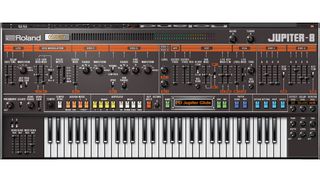A synth now seen as one of Roland’s crowning achievements, even though relatively few units were sold at the time, the JP-8 has since come to exemplify the pinnacle of polyphonic perfection.
Roland’s first volley in the war of polyphony was launched in 1978. Dubbed the Jupiter-4, it was relatively limited compared to the Sequential Circuits and Oberheims leading the charge. Though it cost far less than those instruments, it was quite expensive for a four-voice, single-oscillator instrument, and sales were less than stellar.
It would take Roland three years to offer musicians a truly viable alternative to the likes of the Prophet-5. With eight dual-oscillator voices and sounds that could be split and layered across the keyboard, the Jupiter-8 had the voice count of a fully loaded Oberheim OB-Xa and was clearly positioned to compete with the Americans.
The JP-8’s architecture was not unlike that of its Yankee cousins, with dual oscillators offering triangle, pulse, square and sawtooth waveforms (and noise for oscillator 2), plus an LFO, a resonant low-pass filter (that, like the one on the OB-Xa, could be switched between 12 and 24dB/octave) and a pair of four-stage envelope generators. As Roland often did, they stuck a non-resonant high-pass filter into the works for good measure.
64 preset slots and eight combination slots made the Jupiter-8 an ideal tour companion (even if the poor tuning stability of the earliest models did not), and many a big name hauled the beast to stage and studio. Devout users included Greg Hawkes of the Cars, Tangerine Dream (natch!), Bryan Ferry, Thomas Dolby, Rush, Barry Andrews (Shriekback), and Ron Mael of Sparks. Michael Boddicker slathered JP-8 textures all over Michael Jackson’s Thriller.
The sound of the Jupiter-8 was the epitome of ‘analogue mojo’, and it’s nigh on impossible to precisely reproduce. This accounts somewhat for the insane prices commanded by secondhand units. Just as they did 30 years ago, those who want a bit of Roland magic for less money often make do with one of the company’s many follow-ups and spin-offs from the Jupiter line. The rest of us can look to samples and the many virtual polysynths inspired by the mighty Jovian Giant.
The plugin Jupiters

Roland Cloud
Roland have attempted to bottle the essence of the Jupiter-8 a few times over the years, always tied to a hardware interface. Their most recent recreation comes in the form of a VST/AU plugin available through their new Roland Cloud subscription service and integrates with - but does not require - their System-8 Plug-out hardware.

Arturia JUP-8V
As with previous Arturia clones, the pedigree of this Jupiter-8 emulation is now being thinly disguised. Don’t let the truncated name and absence of Roland’s logo (or, indeed, any mention of the Japanese company) fool you - this cross-platform plugin has all the features that made the Jupiter-8 a pleasure to patch and play.
Read Arturia Jupiter-8V review

GTG K1 Polysynth
With such a rich heritage, it’s no surprise that Roland are quite pernickety when it comes to protecting their intellectual property, so few developers bother to create obvious Jupiter-8 clones. Still, there are a few plugins that have clearly been inspired by the JP-8, and this little Windows gem is one of them. Added delay and chorus beef up the sound.




